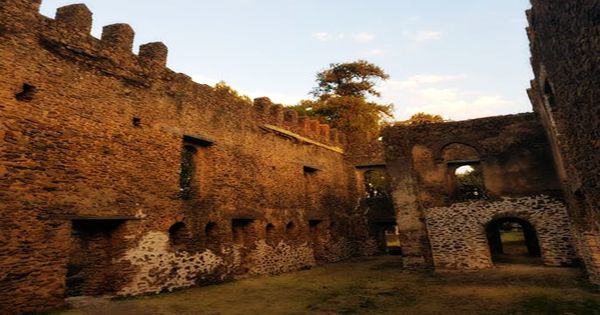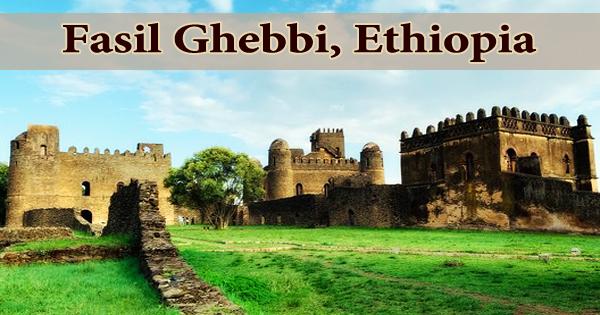The Fasil Ghebbi (Amharic: ፋሲል ግቢ) is situated in the Amhara National Regional State of the Federal Democratic Republic of Ethiopia, in the North Gondar Administrative District. It is a fortress that was built by Emperor Fasilides in the 17th century and served as the residence of Ethiopian emperors. There are eight sections to the serial property. The Castle of Emperor Fasilidas, the Castle of Emperor Iyasu, the Library of Tzadich Yohannes; the Chancellery of Tzadich Yohannes; the Castle of Emperor David, the Palace of Mentuab, and Banqueting Hall of the Emperor Bekaffa are all situated inside the Fasil Ghebbi palace complex. The distinctive architecture represents a wide variety of influences, including Nubian styles.
The remaining seven components are located in and around the city of Gondar: the Debre Berhan Selassie (Monastery and church); the Bath of Fasilidas; Kiddush Yohannes; Qusquam (Monastery and Church); Thermal Area; the Sosinios (also known as Maryam Ghemb); the Gorgora (Monastery and Church) and the Palace of Guzara. In 1979, the site was listed as a UNESCO World Heritage Site. The Amharic word ghebbi means “compound” or “enclosure.” It was designed by Emperor Fasiladas, who became unhappy with his predecessors’ migratory semi-nomadic lifestyle and decided to make a statement by constructing a grandiose palace complex that was one of the most majestic structures of the period.

Ethiopian rulers often relocated their royal camps between the thirteenth and seventeenth centuries. In 1636, King Fasil (Fasilidas) settled in Gondar and made it his permanent capital. The royal court had grown from a camp into a fortified compound called Fasil Ghebbi, which consisted of six main building complexes and other ancillary buildings, surrounded by a 900-meter-long wall with twelve entrances and three bridges until its decline in the late eighteenth century.
The Fasil Ghebbi has its origins in the Ethiopian emperors’ old custom of moving around their territories, living off the produce of the peasants and sleeping in tents. This precinct was sometimes referred to as a katama (“camp” or “fortified settlement”) or makkababya, the name given to the imperial camp in the Royal Chronicle of Baeda Maryam, reflecting this relation.
The Royal Enclosure, which is enclosed by a 900-meter wall, includes a collection of churches, palaces, and monasteries, each with its own architectural style. Many of the early designs are strongly inspired by Hindu and Arabic architecture, with subsequent occupiers applying their own touches to the pre-existing structures. Later additions display Portuguese, Moorish, and Aksumite influences. Fasil Ghebbi is about 70,000 square meters in size. To the south, Adababay, Gondar’s market place, where imperial proclamations, troops were displayed, and criminals were executed, is now a city park.

No one knows why this location was chosen as Ethiopia’s capital, but it was prophesied that an Ethiopian capital would be established at a location beginning with the letter G. The legend spawned a string of towns in the 16th and 17th centuries, including Guzara, Gorgora, and finally Gondar. The fortress city functioned as the center of the Ethiopian government until 1864. Twenty Palaces, royal houses, ornately decorated temples, monasteries, and other unique public and private structures have been transformed by the Baroque style introduced to Gondar by the Jesuit missionaries. Massive towers and looming battlemented walls define the main fortress, which looks like a piece of medieval Europe transplanted to Ethiopia.
Emperor Fasilidas designed Enqualal Gemb, also known as the Egg Castle because of its egg-shaped dome roof, and it is one of the most prominent structures in the compound. The Fasiladas prayer room, which towers above Enqualal Gemb and offers 360-degree views of Gondar, is located above Enqualal Gemb. Dawit’s Hall is situated in the enclosure’s northern portion, near the Bakaffa-built structure and the Asasame Qeddus Mikael church, and is known as the “House of Song.” It was described as a “substantial one-story building with a round tower at the southeast corner,” as well as traces of a smaller round tower at the northeast corner and traces of a square tower at the northwest corner, “the majority of which has collapsed.” “The regular arched windows and doorways offered light and access,” according to the building’s interior, which is a single long corridor.

The Palace of Iyasu, which was the first to be constructed in the city, is located to the northeast of the complex. The palace was built during the reign of Iysau I (1682-1706), the Gonderine period’s greatest monarch. Iyasu Palace was once decorated with glistening Venetian glassware and decadent gold-plated ivory artwork and is noted for its saddle form and rare vaulted ceilings. A two-story pavilion of a bathing palace associated with Emperor Fasilidas is situated outside the city’s confines to the north-west by the Qaha River. The structure is a two-story battlemented structure that sits inside and on one side of a rectangular pool of water filled by a canal from a nearby river. The bathing pavilion is built on pier arches and has many rooms linked by a stone bridge that can be raised for protection.
Fasil Ghebbi is surrounded by a curtain wall with twelve gates piercing it. The banquet hall and granary are situated to the north of Iysau’s Palace. The building was once decorated in intricate artwork, but during the Italian occupation of Ethiopia, it was sadly plastered over. The last palace on site, Mentewab’s Castle, a two-story castle that now serves as the site office, was designed by Emperor Bakaffa. Following rulers, such as Iyasu the Great, continued to build, improving the techniques and architectural style, and expanding the city to the hills north-west of the city center, in the Qusquam region. Fasil Ghebbi and the other Gondar city ruins show a remarkable interface between internal and external cultures, with cultural elements linked to the Ethiopian Orthodox Church, Ethiopian Jews, and Ethiopian Muslims.
Fasil Ghebbi is open Monday through Sunday from 8:30 a.m. to 17:30 p.m. It is possible to visit the Royal Enclosure in the morning or afternoon. It is often included as part of a larger city tour of Gondar, but it is the city’s main attraction. Gondar remained an important commercial and transportation center for northwest Ethiopia throughout the nineteenth century. Some of the monuments also serve a sacred function, and the surrounding landscape retains important cultural significance for the locals.
Information Sources:





